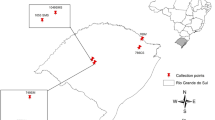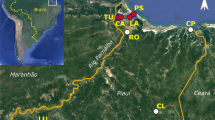Abstract
The genetic diversity of seven wild populations of the grass Brachypodium distachyon (2n = 10), 4 of B. stacei (2n = 20) and 13 of B. hybridum (2n = 30) from the Mediterranean and southern areas of the Iberian Peninsula was studied via the analysis of microsatellite (SSR) and inter-microsatellite (ISSR) markers. The 11 SSR markers analysed provided a total of 156 polymorphic fragments. The B. hybridum populations returned more fragments (98) than the B. stacei populations (87), and more than twice the number recorded for the B. distachyon populations (44). Some fragments were specific to the B. distachyon (3.85 %), B. stacei (27.56 %) or B. hybridum populations (18.58 %). The analysis of 16 ISSR markers returned similar results: the B. hybridum populations returned more polymorphic fragments than the B. distachyon or B. stacei populations. The analysis of molecular variance, with distances between individuals, populations and species estimated on the basis of the presence/absence of the SSR and ISSR fragments, showed most of the variation (67 %) to occur among populations. This was followed by differences among individuals within populations (24 %), and finally among species (9 %). Grouping based on UPGMA and principal coordinate analysis showed a clear separation of three groups corresponding to the populations of the same species. Principal component analysis, involving chromosome number, low-molecular weight-glutenin subunits and the most influential climatic and geographic factors, was also performed. This revealed an obvious separation among the populations of B. distachyon and B. hybridum. The index of Mediterraneity and altitude explained 70.56 % of the total variation associated with the first axis. A trend was seen towards a greater presence of B. distachyon forms in areas of the Peninsular interior and higher altitude, with the B. hybridum forms more common in regions of greater summer rainfall and a lower index of Mediterraneity.






Similar content being viewed by others
References
Brantestam KA, Von Bothmer R, Rashal I, Weibull J (2004) Changes in the genetic diversity of barley of Nordic and Baltic origin, studied by isozyme electrophoresis. Plant Genet Res Charact Util 1:143–149
Catalán P, Müller J, Hasterok R, Jenkins G, Mur LA, Langdon T, Betekhtin A, Siwinska D, Pimentel M, López-Alvarez D (2012) Evolution and taxonomic split of the model grass Brachypodium distachyon. Ann Bot 109(2):385–405
Christiansen P, Andersen CH, Didion T, Folling M, Nielson KK (2005) A rapid and efficient transformation protocol for the grass Brachypodium distachyon. Plant Cell Rep 23:751–758
Draper J, Mur LA, Jenkins G, Ghosh-Biswas GC, Bablak P, Hasterok R, Routledge APM (2001) Brachypodium distachyon. A new model system for functional genomics in grasses. Plant Physiol 127:1539–1555
Filiz E, Ozdemir BS, Tuna M, Budak H (2009) Diploid Brachypodium distachyon of Turkey: molecular and morphologic analysis. In: Yamada T, Spangenberg, G (eds) Molecular breeding of forage and turf. doi:10.1007/978-0-387-39144-9_7; © Spring Science + Business Media, LIC 2009.
Garvin FD, Gu YQ, Hasterok R, Hazen PS, Jenkins G, Mocker TC, Mur AJ, Vogel P (2008) Development of genetic and genomic research resources for Brachypodium distachyon, a new model system for grass crop research. Crop Sci 48(S1):569–584
Gavilán RG (2005) The use of climatic parameters and indices in vegetation distribution. A case study in the Spanish Sistema Central. Int J Biometerorol 50:111–120
Giraldo P, Rodríguez-Quijano M, Vázquez JF, Carrillo JM, Benavente E (2012) Validation of microsatellite markers for cytotype discrimination in the model grass Brachypodium distachyon. Genome 55:525–527
Golenberg EM (1988) Outcrossing rates and their relationship to phenology in Triticum dicoccoides. Theor Appl Genet 75:937–944
Hammami R, Cuadrado A, Jouve N, Soler C, González JM (2011a) Callus induction and plant regeneration in Brachypodium distachyon with different chromosome numbers. Biol Plant 55(4):797–800
Hammami R, Jouve N, Cuadrado A, Soler C, González JM (2011b) Prolamin storage proteins and alloploidy in wild populations of the small grass Brachypodium distachyon (L.) P. Beauv. Plant Syst Evol 297(1–2):99–112
Hasterok R, Draper J, Glyn J (2004) Laying the cytotaxonomic foundations of a new model grass, Brachypodium distachyon (L.) Beauv. Chromosom Res 12:397–403
Hasterok R, Dulawa J, Jenkins G, Leggett M, Langdon T (2006a) Multi-substrate chromosome preparations for high throughput comparative FISH. BMC Biotechnol 6:20
Hasterok R, Marasek A, Donnison IS, Armstead I, Thomas A, King IP, Wolny E, Idziak D, Draper J, Jenkins G (2006b) Alignment of the genomes of Brachypodium distachyon and temperate cereals and grasses using bacterial artificial chromosome landing with fluorescence in situ hybridization. Genetics 173:349–362
Hawkes JG (1980) Crop genetic resources. Field collection manual for seed crops, root and tuber crops, tree fruit crops and related wild species. International Board for plant Genetic Resources (I.B.P.G.R) and the European Association for Research on Plant Breeding (EUCARPIA).
Huangfu Ch, Song X, Qiang S (2009) ISSR variation within and among wild Brassica juncea populations: implication for herbicide resistance evolution. Genet Resour Crop Evol 56:913–924
Humira S, Deshmukh RK, Sharma A, Singh VP, Gupta DK, Gacche RN, Rana JC, Singh NK, Sharma TR (2011) Genome-wide distribution and organization of microsatellites in plants: an insight into marker development in Brachypodium. PLoS One 6(6):e21298
IBI (2010) Genome sequencing and analysis of the model grass Brachypodium distachyon. Nature 463:763–768
Idziak D, Hasterok R (2008) Cytogenetic evidence of nucleolar dominance in allotetraploid species of Brachypodium. Genome 51:387–391
Idziak D, Betekhtin A, Wolny E, Lesniewska K, Wright J et al (2011) Painting the chromosomes of Brachypodium: current status and future prospects. Chromosoma 120:469–479
Jaroszewicz AM, Kosina R, Stankiewicz PR (2012) RAPD, karyology and selected morphological variation in a model grass, Brachypodium distachyon. Weed Res 52(3):204–216
Khan MJ (1992) Seed protein electrophoretic pattern in Brachypodium P. Beauv. species. Ann Bot 70:61–68
Landjeva S, Tsanev V, Korzun V, Vladova R, Ganeva G (2006) Distribution of the wheat-rye translocation 1RS.1BL among bread wheat varieties of Bulgaria. Plant Breed 125:102–104
Larré C, Penninck S, Bouchet B, Lollier V, Tranquet O, Denery-Papini S, Guillon F, Rogniaux H (2010) Brachypodium distachyon grain: identification and subcellular localization of storage proteins. J Exp Bot 61(6):1771–1783
Laudencia-Chingcuanci DL, Vensel WH (2008) Globulins are the main seed storage proteins in Brachypodium distachyon. Theor Appl Genet 117:555–563
Liu D, He X, Liu G, Huang B (2011) Genetic diversity and phylogenetic relationships of Tadehagi in southwest China evaluated by inter-simple sequence repeat (ISSR). Genet Resour Crop Evol 58:679–688
López-Alvarez D, López-Herranz ML, Betekhtin A, Catalán P (2012) A DNA barcoding method to discriminate between the model plant Brachypodium distachyon and its close relatives B. stacei and B. hybridum (Poaceae). PLoS One 7(12):e51058
Monte JV, Casanova C, Soler C (1999) Genetic variation in Spanish populations of the genus Aegilops revealed by RAPDs. Agronomie 9:419–427
Mur LA, Allainguillaume J, Catalán P, Hasterok R, Jenkins G et al (2011) Exploiting the Brachypodium tool box in cereal and grass research. New Phytol 191:334–347
Naxin H, Vogel JP, Lazo GR, You FM, Ma Y, McMahon S, Dvorak J, Anderson OD, Luo MCh, Yong Q (2009) Structural characterization of Brachypodium genome and its syntenic relationship with rice and wheat. Plant Mol Biol 70:47–61
Nevo E (1978) Genetic variation in natural populations: patterns ant theory. Theor Popul Biol 13:121–177
Nieto RM, Casanova C, Soler C (2000) Characterization and evaluation of a collection of wild Spanish populations of the genus Elymus and Thinopyrum using morphological and agronomical traits. Agronomie 20:111–122
Nieto RM, Soler C, García P (2003) Genetic diversity in wild Spanish populations of Thinopyrum junceum and Thinopyrum junceiforme using endosperm proteins and PCR-based markers. Hereditas 139:18–27
Opanowicz M, Vain P, Draper J, Parker D, Doonan JH (2008) Brachypodium distachyon: making hay with a wild grass. Trends Plant Sci 13:172–177
Peakall R, Smouse P (2006) GENALEX 6: genetic analysis in Excel. Population genetic software for teaching and research. Mol Ecol Notes 6:288–295
Peakall T, Smouse P (2012) GenAIEx 6.5: genetic analysis in Excel. Population genetic software for teaching and research: an update. Bioinformatics 28:2537–2539
Prabhu R, Meenakshi N (2013) Genetic diversity studies in ragi (Eleusine coracana (L.) Gaertn.) with SSR and ISSR markers. Mol Plant Breed 4(17):141–145
Pradeep Redy M, Sarta N, Siddiq A (2002) Inter simple sequence repeat (ISSR) polymorphism and its application in plant breeding. Euphytica 128:9–17
Rivas-Martinez S (1983) Nuevo índice de termicidad para la región Mediterránea. In: Blanco de Pavlos A (ed) Avances sobre la investigación en Bioclimatología. C.S.I.C. Salamanca pp 370–380
Robertson IH (1981) Chromosome numbers in Brachypodium Beauv. (Gramineae). Genetic 56:55–60
Rolf JF (1998) NTSYS-pc Numerical taxonomy and multivariate analysis system. Pc version 2.02. Exeter Publications, Setauket, New York
Sanders TB, Hamrick JL (1980) Variation in the breeding system of Elymus Canadensis. Evolution 34:117–122
Schoen DJ, Clegg MT (1985) The influence of flower color on outcrossing rate and male reproductive success in Ipomoea purpurea. Evolution 39:1242–1249
Sneath PHA, Sokal RR (1973) Numerical Taxonomy. W.H. Freeman and Company, San Francisco, p 573
Soler C, Casanova C, Rojo A (2004) Desarrollo de cubiertas vegetales a partir de gramíneas seleccionadas, para su explotación en tierras de olivar Actas de Horticultura Nº41 II Congreso de Mejora Genética de Plantas León 2004
Stebbins GL (1957) Self fertilization and population variability in the higher plants. Am Nat 91:337–354
Stebbins GL (1975) Shrubs as centers of adaptive radiation and evolution. In: Stutz HC (ed) Proceedings: symposium and workshop on wildland shrubs, pp 120–140
Tanya P, Taeprayon P, Hadkam Y, Srinives P (2011) Genetic diversity among Jatropha and Jatropha-related species based on ISSR markers. Plant Mol Biol 29:252–264
Terzopoulos PJ, Bebeli PJ (2008) Genetic diversity of Mediterranean faba bean (Vicia faba L.) with ISSR markers. Field Crops Res 108:39–44
Thornthwaite CW (1948) An approach toward a rational classification of climate. Geogr Rev 38(1):55–94
Vogel JP, Tuna M, Budak H, Huo N, Gu YQ (2009) Development of SSR markers and analysis of diversity in Turkish populations of Brachypodium distachyon. BMC Plant Biol 9:88
Wolny E, Hasterok R (2009) Comparative cytogenetic analysis of the genome of the model grass Brachypodium distachyon and its close relatives. Ann Bot 104:873–881
Wolny E, Lesniewska K, Haterok R, Langdon T (2010) Compact genomes and complex evolution in the genus Brachypodium. Chromosoma. doi:10.1007/s00412-010-0303-8
Yang H, Sweetingham MW, Cowling WA, Smith PMC (2001) DNA fingerprinting based on microsatellite-anchored fragment length polymorphisms, and isolation of sequence-specific PCR markers in lupin (Lupinus angustifolius L.). Mol Breed 7:203–209
Zietkiewicz E, Rafalski A, Labuda D (1994) Genome fingerprinting by simple sequence repeat (SSR)-anchored polymerase chain reaction amplifications. Genomics 20:176–183
Acknowledgments
This study was funded by Grants from the Spanish Ministry of Science and Innovation (AGL 2009-10373 and AGL2012-34052). The authors thank Adrian Burton for linguistic assistance.
Author information
Authors and Affiliations
Corresponding author
Electronic supplementary material
Below is the link to the electronic supplementary material.
Rights and permissions
About this article
Cite this article
Hammami, R., Jouve, N., Soler, C. et al. Genetic diversity of SSR and ISSR markers in wild populations of Brachypodium distachyon and its close relatives B. stacei and B. hybridum (Poaceae). Plant Syst Evol 300, 2029–2040 (2014). https://doi.org/10.1007/s00606-014-1021-0
Received:
Accepted:
Published:
Issue Date:
DOI: https://doi.org/10.1007/s00606-014-1021-0




